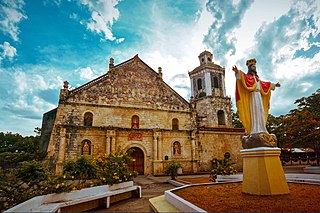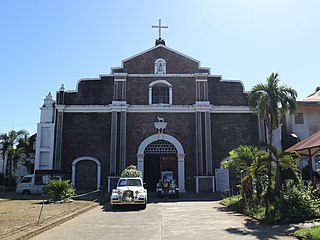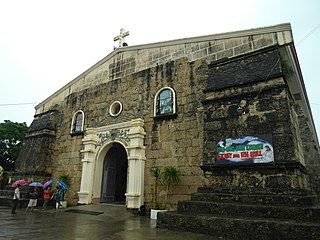
Iloilo, officially the Province of Iloilo, is a province in the Philippines located in the Western Visayas region. Its capital and largest city is Iloilo City, the regional center of Western Visayas. Iloilo occupies a major southeast portion of the Visayan island of Panay and is bordered by the province of Antique to the west, Capiz to the north, the Jintotolo Channel to the northeast, the Guimaras Strait to the east, and the Iloilo Strait and Panay Gulf to the southwest.

Iloilo City, officially the City of Iloilo, is a 1st class highly urbanized city in the Western Visayas region of the Philippines, located on the southeastern coast of the island of Panay. It is the capital city of the province of Iloilo, where it is geographically situated and grouped under the Philippine Statistics Authority, but remains politically independent in terms of government and administration. In addition, it is the center of the Iloilo–Guimaras Metropolitan Area, as well as the regional center and primate city of the Western Visayas region. According to the 2020 census, Iloilo City has a population of 457,626 people. For the metropolitan area, the total population is 1,007,945 people.

The Archdiocese of Jaro is a Latin Church archdiocese of the Catholic Church headquartered in Jaro, Iloilo City, Philippines. Its episcopal see is at the Metropolitan Cathedral of St. Elizabeth of Hungary, also the National Shrine of Our Lady of Candles, as its seat. The metropolitan archdiocese covers the provinces of Iloilo and Guimaras, an island off Iloilo. Its titular patron saint is Elizabeth of Hungary, whose feast is celebrated on November 17.

Mina, officially the Municipality of Mina, is a 5th class municipality in the province of Iloilo, Philippines. According to the 2020 census, it has a population of 24,042 people.

San Joaquin, officially the Municipality of San Joaquin, is a 2nd class municipality in the province of Iloilo, Philippines. According to the 2020 census, it has a population of 52,617 people.

Gabriel Martelino Reyes was the 28th archbishop of Manila, and the first native Filipino to hold that post. He previously served as Archbishop of Cebu from 1934 to 1949, and then served as Archbishop of Manila from 1949 till his death in 1952.

Jaro is a district in Iloilo City, Philippines, located on Panay Island in the Western Visayas region. It is the largest district in terms of both area and population, with 130,700 people according to the 2020 census. Jaro merged with Iloilo City in the 1940s during the American administration in the Philippines. It is also the largest among the seven districts of Iloilo City. La Paz district and the present municipalities of Leganes and Pavia were historically part of Jaro before becoming independent.

The Metropolitan Cathedral of Saint Elizabeth of Hungary, also known as the National Shrine of Our Lady of the Candles and colloquially as Jaro Cathedral, is a cathedral located in the district of Jaro in Iloilo City, on the island of Panay in the Philippines. The seat of the Roman Catholic Archdiocese of Jaro, it was placed under the patronage of Saint Elizabeth of Hungary. It was established in 1575 as a visita (chapel-of-ease) of Oton by the Augustinians and as a separate parish in 1587. The present-day structure of Jaro Cathedral was built in 1874.

The Minor Basilica of the Holy Child, locally known as the Basílica Minore del Santo Niño de Cebú and commonly known as Santo Niño Basilica, is a minor basilica in Cebu City in the Philippines that was founded in 1565 by Fray Andrés de Urdaneta and Fray Diego de Herrera. It is the oldest Roman Catholic church in the country, allegedly built on the spot where the image of the Santo Niño de Cebú was found during the expedition of Miguel López de Legazpi.

Ancestral houses of the Philippines or Heritage Houses are homes owned and preserved by the same family for several generations as part of the Filipino family culture. It corresponds to long tradition by Filipino people of giving reverence for ancestors and elders. Houses could be a simple house to a mansion. The most common ones are the "Bahay na Bato". Some houses of prominent families had become points of interest or museums in their community because of its cultural, architectural or historical significance. These houses that are deemed of significant importance to the Filipino culture are declared Heritage House by the National Historical Commission of the Philippines (NHCP), previously known as the National Historical Institute (NHI) of the Philippines. Preservation is of utmost importance as some ancestral houses have come into danger due to business people who buy old houses in the provinces, dismantle them then sell the parts as ancestral building materials for homeowners wishing to have the ancestral ambiance on their houses. These ancestral houses provide the current generation a look back of the country's colonial past through these old houses.

The University of Santo Tomas Central Seminary Building currently houses the Santísimo Rosario Parish, the Central Seminary, and the Faculties of Ecclesiastical Studies of the Pontifical and Royal University of Santo Tomas in Manila. The parish was canonically inaugurated on April 26, 1942, by Michael J. O'Doherty, the Archbishop of Manila. On January 25, 2010, the National Museum of the Philippines formally declared the Central Seminary Building as a National Cultural Treasure.

The Saints Peter and Paul Parish Church, commonly known as Calasiao Church is a baroque church located in Poblacion West, Calasiao, Pangasinan, Philippines. It belongs to the Vicariate of Sts. Peter and Paul under the Ecclesiastical Province of the Roman Catholic Archdiocese of Lingayen-Dagupan. The 57, 840 Catholics is under the pastoral care of Rev. Fidelis B. Layog, assisted by Rev. Isidro Palinar, Jr. and Rev. Raymund Manaois.

The Santa Monica Parish Church, commonly known as the Minalin Church, is a Baroque Roman Catholic church, located in poblacion area of San Nicolas in Minalin, Pampanga, Philippines. The church, built during the Spanish era, was declared a National Cultural Treasure by the National Commission for Culture and the Arts and the National Museum of the Philippines on August 27, 2011, one of 37 churches in the country bestowed that honor.

The Santo Tomás de Villanueva Parish, also known as Miagao Church, is a Roman Catholic church located in Miagao, Iloilo, Philippines. The church was declared as a UNESCO World Heritage Site on December 11, 1993, together with San Agustin Church in Manila; Nuestra Señora de la Asuncion Church in Santa Maria, Ilocos Sur; and San Agustin Church in Paoay, Ilocos Norte under the collective title Baroque Churches of the Philippines, a collection of four Baroque Spanish-era churches.

The University of Santo Tomas Baybayin Documents or UST Baybayin Documents are two 17th century land deeds written in Baybayin script.

St. Andrew the Apostle Parish, commonly known as Bacarra Church is a Roman Catholic church located in the municipality of Bacarra, Ilocos Norte, Philippines under the jurisdiction of the Roman Catholic Diocese of Laoag.

The Santa Barbara Parish Church and Convent is a Roman Catholic church located in the municipality of Santa Barbara, Iloilo, Philippines, under the Archdiocese of Jaro. The church is considered to be the "Cradle of Independence" in Panay and in the Visayas.

The Archdiocesan Shrine of Patrocinio de Maria Santisima, commonly known as Boljoon Church, is a Roman Catholic church dedicated to the Our Lady of the Patronage in the municipality of Boljoon, Cebu, Philippines, under the Roman Catholic Archdiocese of Cebu.

Passi, officially the City of Passi, is a 4th class component city in the province of Iloilo, Philippines. According to the 2020 census, it has a population of 88,873 people.

The San Joaquin Parish Church, commonly known as San Joaquin Church, is a Roman Catholic Church in the municipality of San Joaquin, Iloilo, Philippines within the jurisdiction of the Roman Catholic Archdiocese of Jaro. It is largely known for its pediment featuring a military scene, the Spanish victory over the Moors in the Battle of Tétouan. The church was declared a National Cultural Treasure by the National Museum of the Philippines.





















